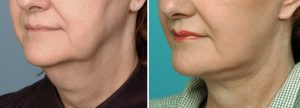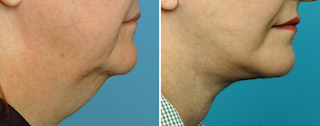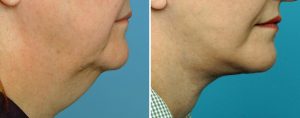Background: The sagging neck is one of the telltale signs of facial aging. While it occurs in everyone eventually, the extent to which it occurs is affected by numerous factors. One factor is the thickness of the neck tissues. As one might surmise thicker neck skin and underlying tissues tends to develop earlier onset and greater amounts of neck sagging due to its weight and volume.
Thicker heavier necks require an aggressive or extended approach to their lower facelift. Long complete flaps that completely elevate the skin from the ears to the central neck and SMAS elevation and plication are important for maximal posterolateral tissue movement. But central neck work is also needed including supraplatysmal liposuction, subplastysmal defatting and midline muscle plication. In short every known standard technique needs to be applied to substantially improve the cervicomental angle and the jawline contour.
But in the thicker neck even with maximal effort some tissue relaxation from the tightening inevitably occurs. This is seen in the submental area under the chin, the central neck area which is the furthest from the posterolateral tissue movements. This is an expected postoperative effect and patients should be so counseled before surgery. This is treated in the first six to twelve months after surgery by a secondary submentoplasty tuck procedure.
Case Study: This early 60ish female had developed a sagging neck, moderate jowling and an overall facial droop from her age and thicker skin.


Case Highlights:
1) The main motivation for most facelift patients of late middle age is a sagging neck.
2) A full lower facelift with long skin flaps and central neck work is needed for a sagging neck with thick skin.
3) Some postoperative submental relaxation can be expected in thick-skinned necks that may require a secondary submentoplasty for correction.
Dr. Barry Eppley
Indianapolis, Indiana




